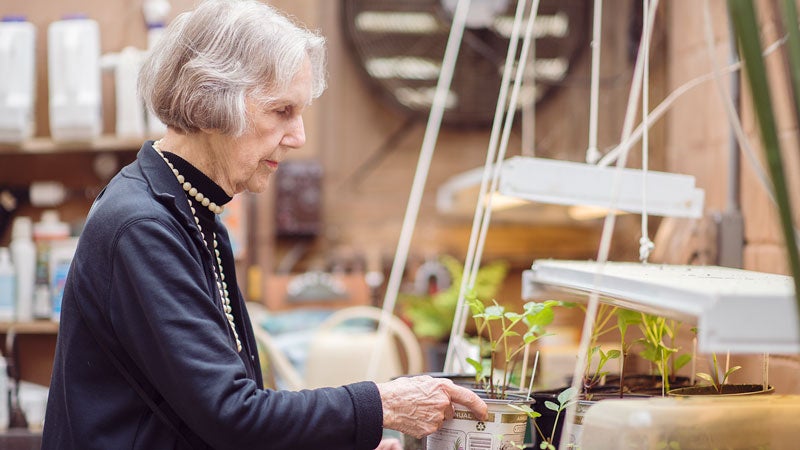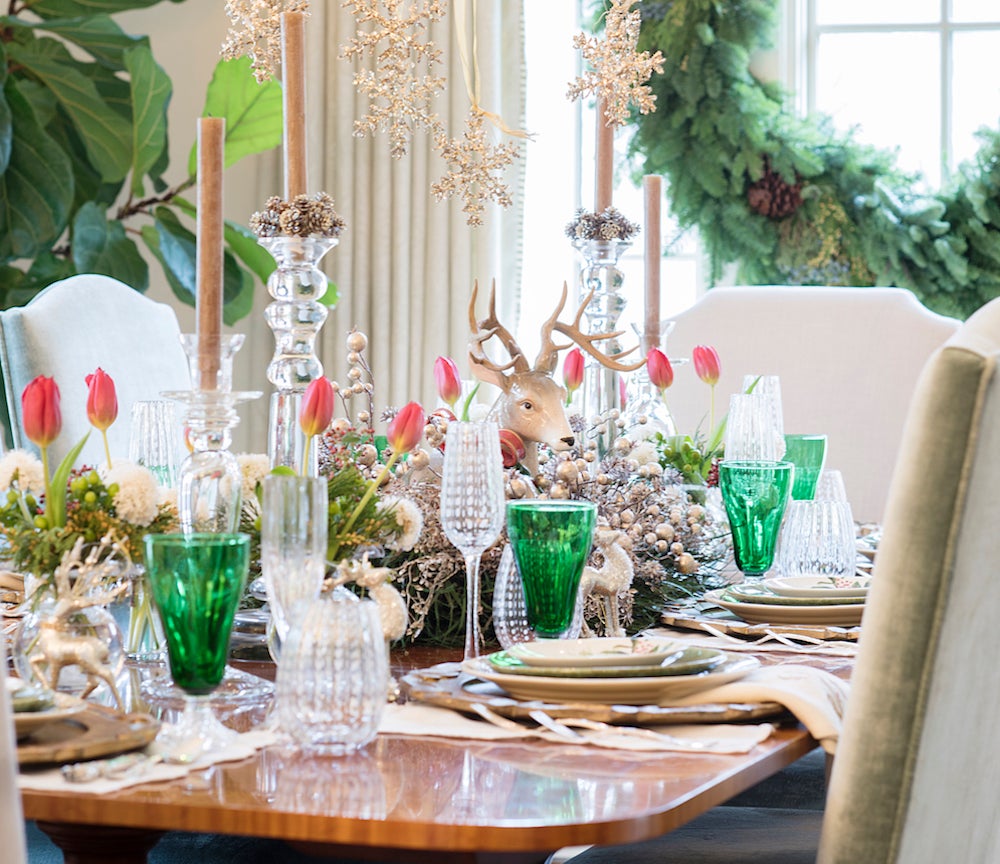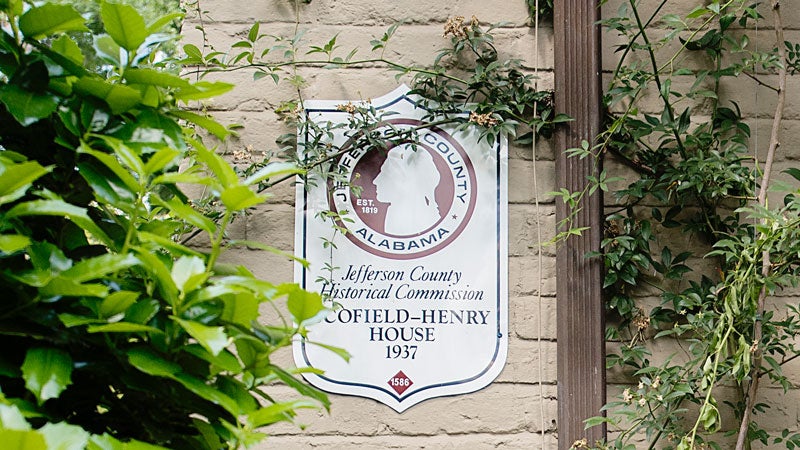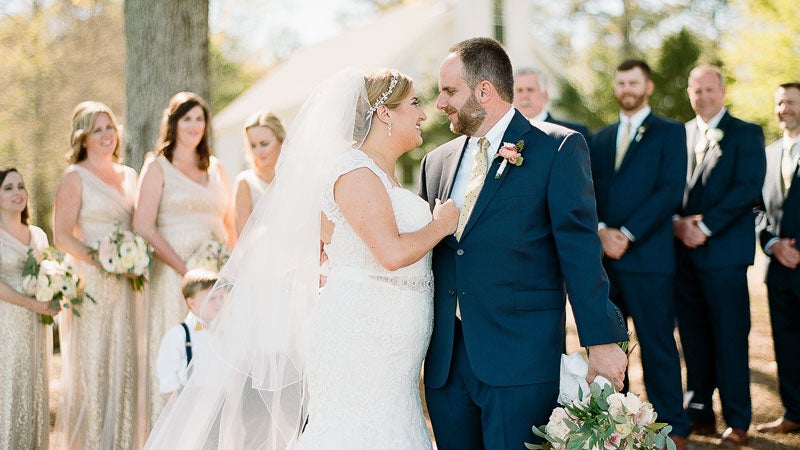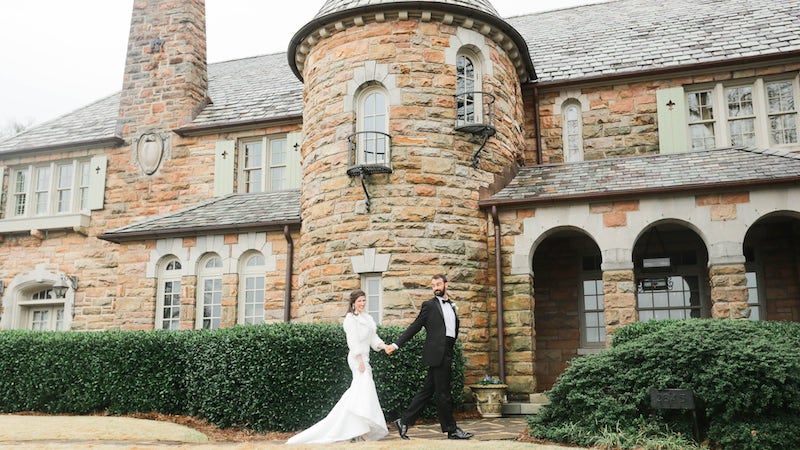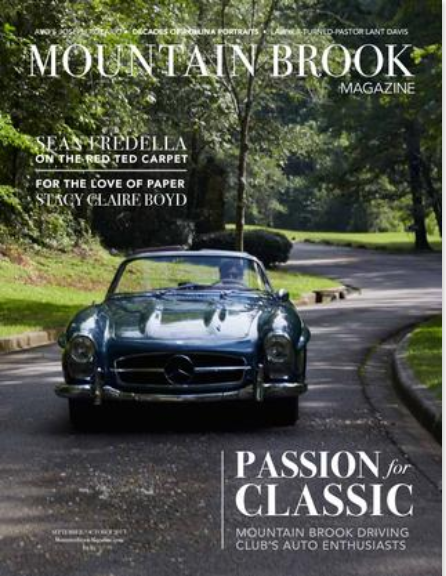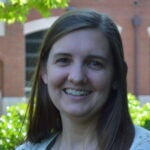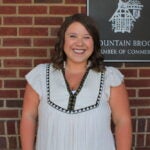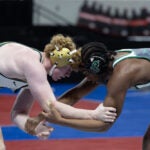The presence of Louise Agee Wrinkle’s mother and father is not far from the all-glass sunroom that provides a panorama of the natural woodland garden they birthed. “Father liked to be in the open, and Mother liked air conditioning,” Louise recounts. “So (this space) was their compromise.” A dark wood chest once held her father Rucker’s map collection, now in safe keeping in the Birmingham Public Library. A distinctly Southern peacock feather high back wicker chair has always been “Miss Hannah’s chair” after the elderly friend of her father’s who gifted it to him. The wall art and the furnishings alike are bedecked in florals, and a live fig vine grows up a brick wall, inside. “Mother left a little piece there where the foundation opened up to the ground,” Louise explains, also noting that without external roots she “kills (plants) as soon as (she) brings them inside.”
The living, breathing botanical expanse that comes up around the room is soothing, almost therapeutic. “I think that’s because it’s natural,” Louise says.
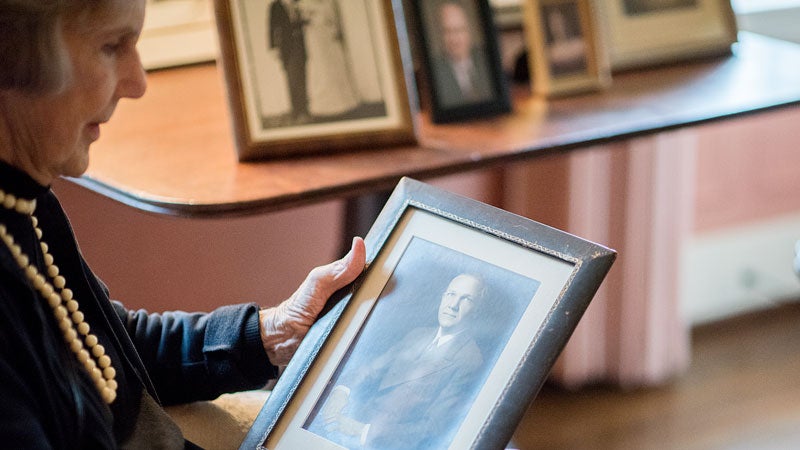
Louise Wrinkle holds a photo of her father, Rucker Agee.
The pages of Louise’s new book Listen to the Land, released last fall, best tell the story of this woodland garden’s decades long journey in the Agee-Wrinkle family, and quite eloquently at that. “My lifelong connection with this piece of Alabama woodland has taught me how to hear its particular voice,” Louise writes. “I have a strong feeling that, as gardeners, we should let the land speak for itself rather than impose our own thoughts and preferences upon it… I have always preferred to listen than to dictate. By listening to this unspoiled piece of Alabama woodland, I’ve learned to nurture and protect its unique nature.”
The book is part garden memoir, part garden guide book and part Mountain Brook history memoir. Louise had first seen the Beechwood Road property when she was 6, riding a pony from the Mountain Brook Riding Academy along a 12-mile trail that followed Watkins Brook and Shades Creek to Mountain Brook Club. At that time, in 1938, to Louise it was “The Jungle” overgrown with honeysuckle, poison ivy and weed trees. Today that jungle is her garden, ripe with dogwoods, pines, tulip poplars, Southern magnolias and other Southern woodland species.
In her earliest memories the garden was a “natural playground” for Louise and her sister, Kitty. Their father, “an avid naturalist and early environmentalist,” took them on walks and taught them the common names of trees. Spend-the-night parties took place in a log cabin that was given to her dad after the Boy Scouts National Jamboree was held in Birmingham in the late 1930s. The cabin is now long since gone, but Louise did run into a man recently who said her first cousin Ted Agee and he used to camp out in there. Today a cutting garden stands in its place, with spring blooms making way for zinnias and dahlias in summer and fall.
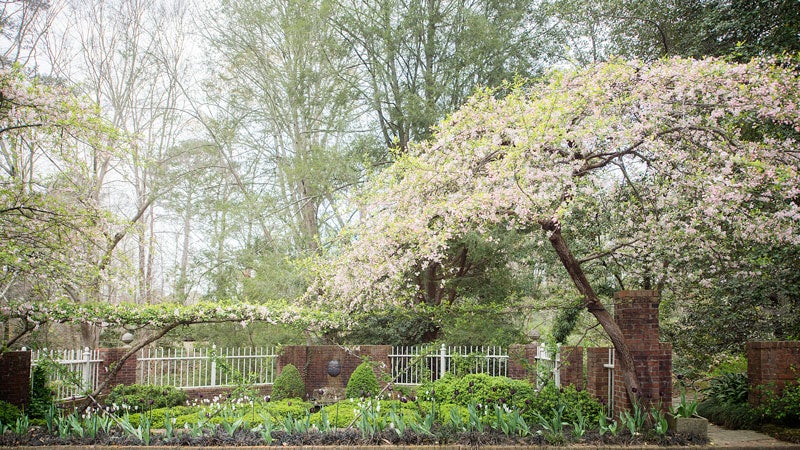 But in Louise’s words, she “never set out to be a plant nut.” In fact, until age 57, horses were her passion, but when her two daughters went off to college, the “plant bug bit.” And when her parents passed away in 1985 and 1986, she and her husband took on their Beechwood Road garden, and their home, and made it their own.
But in Louise’s words, she “never set out to be a plant nut.” In fact, until age 57, horses were her passion, but when her two daughters went off to college, the “plant bug bit.” And when her parents passed away in 1985 and 1986, she and her husband took on their Beechwood Road garden, and their home, and made it their own.
It’s she, of course, who best articulates the garden’s vision: “I wanted this place to be a personal oasis of calm and serenity, protected from the outside, where it could nurture the treasures I am fortunate enough to have here. I want to be in a world apart when I’m here in my garden; I want to see my house, my trees, my grass, not my neighbors. You can call this snobbery, but I want to be left alone to enjoy my garden.”
But Louise’s vision evolved too. At first she thought she wanted exclusively native Southeastern plants, and then she discovered the parallel between U.S. Southeastern natives and “the Orient”: Korea, Japan and China. Today varietals from both regions stand side by side.
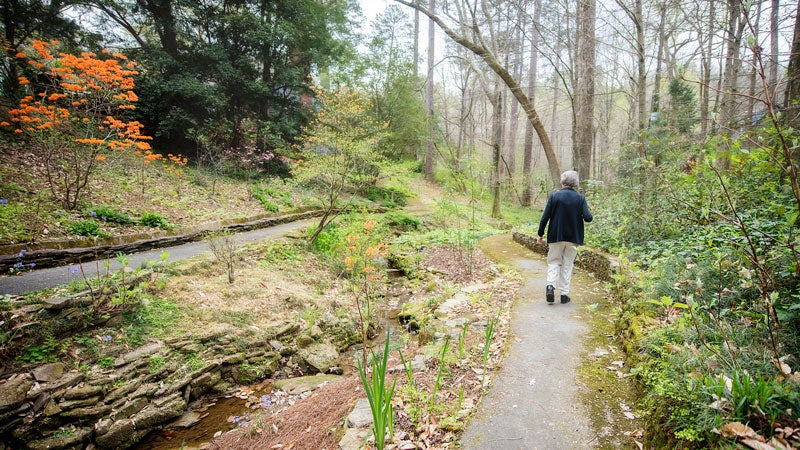 Take a garden tour with her at the end of March, and you’ll get a peek at the garden as spring starts to show its vibrant colors. At one stop, you’ll marvel at the brilliant yellowish-orangish-reddish native azaleas, kept separate from the pink ones since Louise doesn’t like the colors to mix. At another stop she points out the mondo grass, which she has just had cut for the fourth time in 30 years. At another an evergreen dogwood that did so well that she has two younger ones elsewhere—with blooms that are “just spectacular.” At another, pink camellia blooms are just finishing up. At still another she enumerates one, two, three Japanese maple trees, each with a look so distinct you wouldn’t guess they were related.
Take a garden tour with her at the end of March, and you’ll get a peek at the garden as spring starts to show its vibrant colors. At one stop, you’ll marvel at the brilliant yellowish-orangish-reddish native azaleas, kept separate from the pink ones since Louise doesn’t like the colors to mix. At another stop she points out the mondo grass, which she has just had cut for the fourth time in 30 years. At another an evergreen dogwood that did so well that she has two younger ones elsewhere—with blooms that are “just spectacular.” At another, pink camellia blooms are just finishing up. At still another she enumerates one, two, three Japanese maple trees, each with a look so distinct you wouldn’t guess they were related.
And indeed everyone who walks through the garden will see different things. “Something is going on most of the time if you know what to look for,” Louise says. There’s Carolina silverbell, yellow magnolia, andromeda between steps, English bluebells…the list goes on and on. Each species is nestled amongst the natural slope of the land around a constantly flowing stream sourced at a spring two houses up the street. In the late 1980s Louise had a rock wall built lining a then newly constructed paved path that provides for easy walking access to all parts of the garden. In all of it, of course, she’s looked to “what’s dictated by the land” instead of imposing her own plan. As just one of many examples, a rock path winds to follow the contour of the land, instead of cascading straight down.
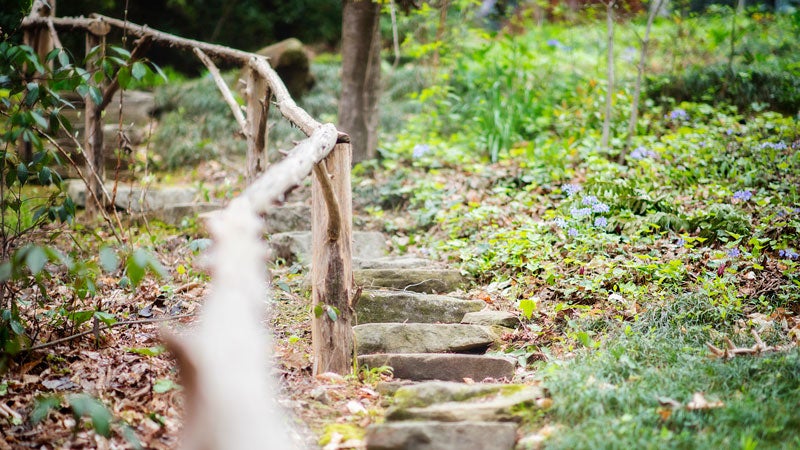 People often ask Louise what her favorite plant is. “It’s usually what I have been working on most recently.” On this particular spring day, the answer is Alexandrian laurel. It’s impervious to extra water, bugs, sun, shade, she notes, although she does have to cut it back. Another favorite? The native crabapple. She likes that it’s a four-season plant. “It blooms and has fruit in the fall,” she says. “In the winter it drops its leaves and everything but it’s very twiggy and has a lot of texture.”
People often ask Louise what her favorite plant is. “It’s usually what I have been working on most recently.” On this particular spring day, the answer is Alexandrian laurel. It’s impervious to extra water, bugs, sun, shade, she notes, although she does have to cut it back. Another favorite? The native crabapple. She likes that it’s a four-season plant. “It blooms and has fruit in the fall,” she says. “In the winter it drops its leaves and everything but it’s very twiggy and has a lot of texture.”
Likewise, it’s no surprise that Louise treasures all seasons in the garden equally: “A lot of people are wedded to flowers and color and dramatic things, and I am more interested in subtle things that develop through the years. I like winter too. The air is crisp and clean, and a lot of times its damp and cold and clear. You can see the liken on the trees and the bark. You see the bones so much better than with all the flowers.“
As Louise will tell you, gardening deals not only in length width and depth but also in time. It’s constantly changing. It must always look forward, always be prepared. As she chronicles in her new book, 1989 proved that with its straight line winds. The Blizzard of 1993 proved that, even taking down a Yoshino cherry Louise’s mother had planted 15 years earlier. 1995 proved that when Hurricane Opal left many downed trees in its path. On this spring particular day, she points out a bare area where the ground cover didn’t do well in one spot, so she’s putting Asiatic jasmine in its place. “You’ve got to keep working on it,” she says.
At age 86, today Louise delegates most of the garden work out, but she’s still the mastermind behind it. She’s ever trying new things. Some work. Some don’t. Most are detailed in her book, no matter their story. “If you don’t see something growing around here or your friends’ gardens, it usually doesn’t grow very well around here,” she explains. But perhaps her statement is more nuanced when applied to her own garden. If a plant isn’t there, it’s simply because Louise listened to the land and nurtured it accordingly.
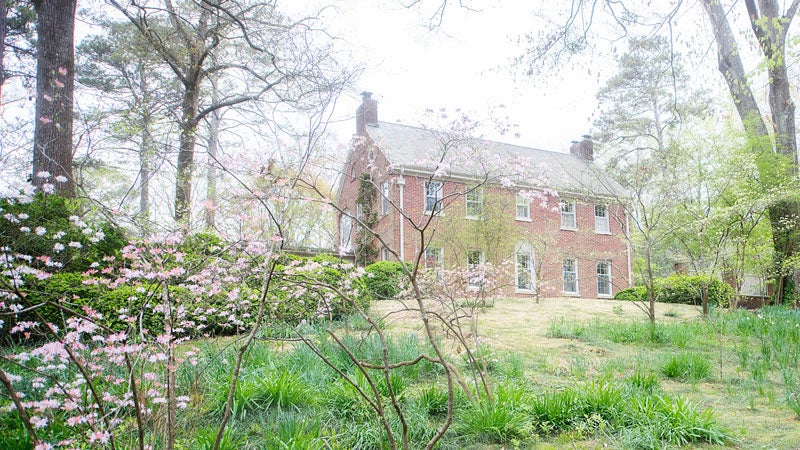
Every Book Has Its Own Story
The roots of Louise Agee Wrinkle’s Listen to the Land go back to a request by a well known British garden photographer for her to write a book and let him take the photos. Very few people stay in one place for 30 years, and she was coming up on that milestone. Maybe it was time to write a book, though she’d never considered herself a writer. (It seems she could keep tapping long-hidden talents for decades, between taking up gardening in her late 50s and writing in her late 80s.) What came into being was two years of her own labor, eloquently telling the tale of her life and her garden, and sharing a wealth of the horticultural knowledge she’s amassed over the years.
These words—honed with assistance from her daughter Margaret, who has written a historical novel, and longtime friend and former Southern Living editor John Floyd, along with Birmingham Botanical Garden executive director Fred Spicer—paired with a compilation of old and new, professional and nonprofessional photographs in a picturesque coffee table volume released last fall. Since the book has come out, she’s started getting more requests for garden tours, and she’s continued to welcome garden clubs from all over and to speak at book signings at Garden Club of America meetings, book festivals and botanical gardens.
Listen to the Land can be purchased online or at Bromberg’s, The Dande Lion, Henhouse Antiques, Leaf & Petal at the Gardens, Little Hardware, Village Poodle, Smith’s Variety and select other local retailers. For more information, visit louisewrinkle.com.

